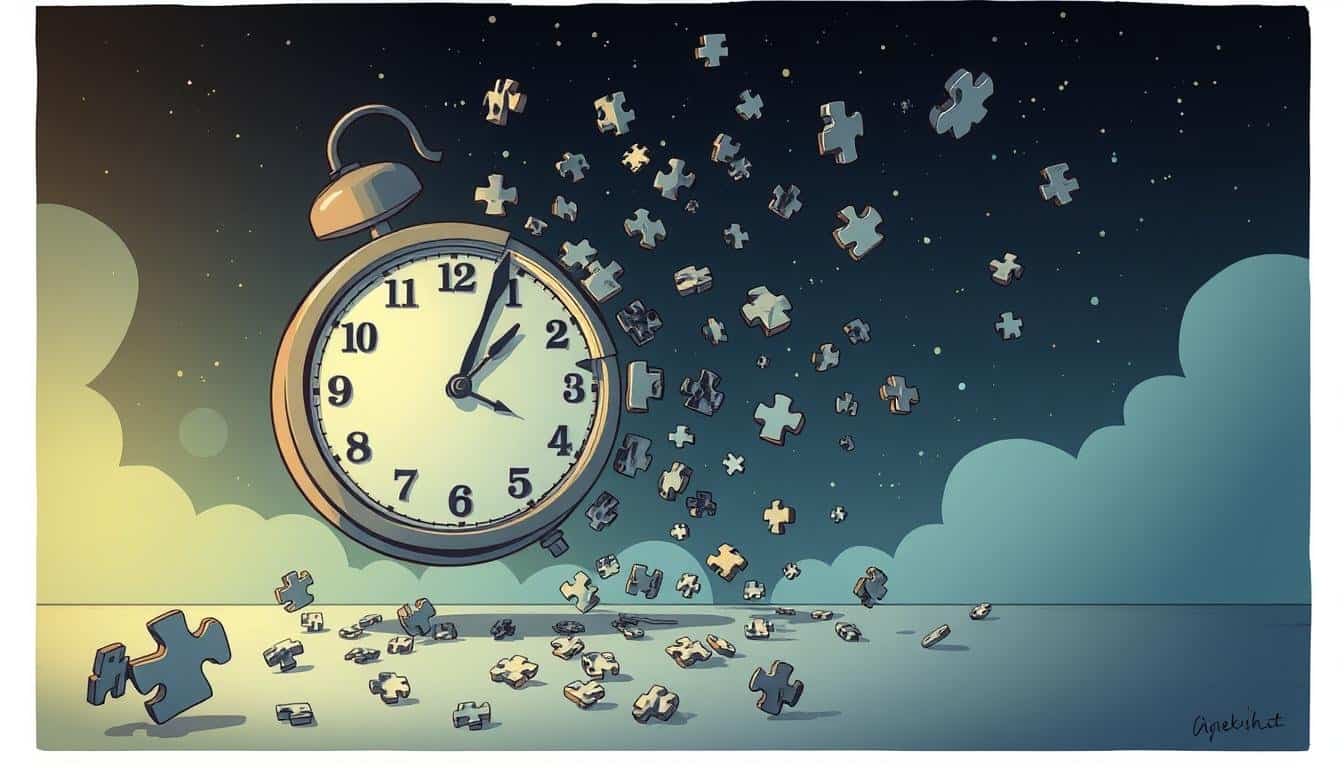Understanding The Zeigarnik Effect in Psychology
Have you ever felt like unfinished tasks keep coming back to your mind? This is the Zeigarnik Effect at work. It’s a key part of our daily lives, affecting how we remember things and finish tasks. This psychological effect shows how tasks we don’t finish stick in our memory more than the ones we complete. It also shows the mental load we carry from unfinished tasks.
The Zeigarnik Effect tells us we remember tasks we didn’t finish better than those we did. This idea is important in areas like cognitive psychology, teaching, and marketing. By looking into this effect, we can find ways to be more productive and feel better mentally.
Key Takeaways
- The Zeigarnik Effect shows an increased ability to recall interrupted rather than completed tasks.
- Utilizing design elements like progress bars can help users instinctively return to incomplete tasks.
- Breaking tasks into smaller, manageable subtasks fosters motivation and decreases overwhelm.
- Ethical applications of the Zeigarnik Effect can improve productivity without leading to burnout.
- Creating an organized task management system helps mitigate the effects of unfinished business.
What is the Zeigarnik Effect?
The Zeigarnik Effect is a key idea in Cognitive Psychology. It shows how we remember unfinished tasks better than ones we’ve finished. This idea came from psychologist Bluma Zeigarnik in 1927. She found that people remember tasks they didn’t finish better than those they did finish.
This shows how our minds keep thinking about things we haven’t done. Adults can recall unfinished tasks 90% better than ones they finished. This means our brains really focus on things that aren’t done yet.
This effect is useful in real life, like in marketing. Advertisers use it to keep us interested. It also helps us learn better if we take breaks during study sessions.
| Key Observations | Details |
|---|---|
| Original Research | Bluma Zeigarnik first reported the effect in 1927. |
| Memory Recall | Participants recalled unfinished tasks 90% more than completed tasks. |
| Marketing Application | Used to engage consumers through suspense and unresolved narratives. |
| Procrastination | Linked to persistent thoughts about tasks left incomplete. |
| Study Techniques | Breaking learning tasks can enhance memory retention. |
The Origins of the Zeigarnik Effect
Bluma Zeigarnik’s work is key to understanding the Zeigarnik Effect. This effect, found in the 1920s, shows how unfinished tasks boost memory. It’s all about how interruptions help us remember things better.
Bluma Zeigarnik’s Observations
Bluma Zeigarnik found something interesting. She noticed waiters remembered unpaid orders better than finished ones. This led her to study more and find out that people remember interrupted tasks 90% better than finished ones.
This discovery helped us understand the Zeigarnik Effect. It shows how our brains keep track of things we haven’t finished.
Influence of Gestalt Psychology
Gestalt Psychology played a big role in Zeigarnik’s work. It’s about seeing the big picture, not just the parts. Bluma Zeigarnik’s research showed how our thoughts and feelings work together when we remember things, especially if they’re not finished.
Her boss, Kurt Lewin, also talked about how unfinished tasks affect our memory and focus. This idea helped explain the Zeigarnik Effect better.
How the Zeigarnik Effect Influences Memory Retention
The Zeigarnik Effect changes how our memory works, especially with unfinished tasks. Research shows that we remember incomplete tasks better than finished ones. This helps us recall unfinished tasks easily.
Unfinished tasks create a mental burden that affects our mood and mental health. This burden increases our cognitive load.
Unfinished Tasks and Memory
Studies reveal that we remember unfinished tasks better than completed ones. Our engagement with the task, our goals, how hard we think it is, and how close we are to finishing it matter. By understanding these factors, we can use the Zeigarnik Effect to improve our productivity and memory.
Breaking tasks into smaller parts, using checklists, and structured breaks can help manage our cognitive resources better.
Psychological Burden of Uncompleted Tasks
Unfinished tasks bring stress and anxiety. This stress comes from knowing we haven’t finished them. Not finishing tasks can also hurt our performance in new tasks.
Creating clear plans for our goals improves memory and manages cognitive load. Using AI tools like virtual assistants can make managing tasks easier and show us what we haven’t done, easing the mental strain.
The Role of Attention in the Zeigarnik Effect
Attention is key to understanding The Zeigarnik Effect. When we start a task, our mind notes it as unfinished. This makes us want to finish it. It shows how attention and memory work together in our minds.
Dealing with many tasks can be tough. Switching between tasks can break our focus. Research shows that perfectionists often feel more anxious because of The Zeigarnik Effect. They worry too much about details and unfinished projects.
This effect can even affect our sleep. Our minds keep going over all the tasks we didn’t finish. Using strategies like Needle Movers lists and a “Second Brain” can help manage this.
Knowing how attention helps us with unfinished tasks can improve our focus. In Dr. Zeigarnik’s studies, people found breaks helped their memory. Learning to use attention with The Zeigarnik Effect can make us more productive and mentally well.
The Science Behind the Zeigarnik Effect
The Zeigarnik Effect shows how interruptions affect our memory and recall. Bluma Zeigarnik did a lot of research on this topic. Her work gave us key insights into how this effect works and its uses in different areas.
Initial Experiments Conducted by Zeigarnik
Zeigarnik started her research by asking people to do tasks. Some got interrupted, while others finished their work. Those who got interrupted could remember the tasks better, showing a strong link between interruptions and memory.
This proved Zeigarnik’s idea right. She found that tasks we don’t finish stick in our minds more. This idea has big implications for how we learn and remember things.
Results of Zeigarnik’s Research
Zeigarnik’s studies showed that tasks we don’t finish are easier to remember. People could recall these tasks up to 90% better. This finding has changed how we think about memory and learning.
It has also led to new ways to improve memory in schools, marketing, and even personal development.
The Zeigarnik Effect and Cognitive Psychology
The Zeigarnik Effect is a key part of cognitive psychology, especially in memory theory. It shows that people remember tasks that are not finished better than those that are complete. This effect creates an Open Cognitive Loop that deeply affects how we think.
A study at the University of California, Irvine, showed that after 20 minutes of interruptions, people felt more stressed and frustrated. Unfinished tasks keep our brains busy, making us feel overwhelmed.
Managing tasks better can ease this mental load. For instance, breaking big projects into smaller parts with deadlines helps our brains feel like we’re making progress. This boosts motivation and keeps us wanting to finish what we started.
Using tools with progress bars or checkpoints can use the Zeigarnik Effect well. These tools show how much we’ve done and what’s left, making our minds less cluttered. Early Fitbit users, for example, were more engaged when trying to fill five dots to show their daily activity goals.
Applying the Zeigarnik Effect in education can also improve learning. Taking breaks during learning, not just at the end, helps solidify memories and process information better.
| Strategy | Description | Benefits |
|---|---|---|
| Break Projects Into Milestones | Divide larger tasks into smaller, manageable parts with deadlines. | Improves focus and reduces overwhelm. |
| Use Progress Indicators | Incorporate visual cues like progress bars to track task completion. | Increases engagement and motivation. |
| Scheduled Breaks | Implement breaks mid-task to foster mental clarity. | Enhances learning retention and problem-solving capabilities. |
Learning about the Zeigarnik Effect helps us create better solutions for user behavior and boosts productivity.
Examples of the Zeigarnik Effect in Everyday Life
The Zeigarnik Effect shows up in many parts of our lives. It affects how we remember tasks and experiences. It’s seen in schools and in marketing, showing how unfinished tasks shape our behavior and memory.
Application in Education
Students often remember material better just before exams. This happens when the information is still on their minds. It shows how important good study habits are.
Studying in short, focused periods helps students use the Zeigarnik Effect. This leads to better understanding and memory.
Use in Marketing and Advertising
Marketers use the Zeigarnik Effect to grab our attention. They create cliffhangers in ads to keep us wanting more. This keeps us interested and helps us remember the product better.
Unfinished stories make us curious and bring us back to the brand. This shows that unfinished stories can really affect what we buy.
| Context | Application | Outcome |
|---|---|---|
| Education | Short study sessions with breaks | Better retention and understanding |
| Marketing | Cliffhangers and unresolved narratives | Increased consumer engagement |
| Workplace | Breaking tasks into smaller pieces | Higher productivity and lower stress |
Potential Downsides of the Zeigarnik Effect
The Zeigarnik Effect helps improve memory and focus, but it also has downsides. These can affect how we feel and think. It’s key to know these downsides to keep a healthy balance.
Negative Impacts on Mental Wellbeing
One big downside is more stress and anxiety from unfinished tasks. This can make it hard to relax and think clearly. Studies show that not finishing tasks can keep your mind racing, hurting your mental health.
Feeling like you can’t finish tasks can make you feel not good enough. This can lead to burnout if not managed.
Effects on Procrastination and Task Completion
Some people might put off tasks because of the Zeigarnik Effect. This can start a cycle of guilt and frustration. It’s important to plan and break tasks into smaller steps to avoid this.
Using the ten-minute rule can help use the Zeigarnik Effect for good. It makes completing tasks less stressful and overwhelming.
Real-World Applications of the Zeigarnik Effect
The Zeigarnik Effect is very useful in many areas, like improving how we study and work. It shows us that tasks we don’t finish stick in our memory better. This helps us learn and work more efficiently.
Improving Study Techniques
In schools, using the Zeigarnik Effect can really help students study better. For instance, taking breaks during study sessions can help us remember more. Studies show we remember tasks we didn’t finish up to 90% better than those we did finish.
This means students can stop rehearsing before they fully memorize something. It makes remembering things during exams easier. Breaking down big lists or definitions into smaller, unfinished parts also helps us remember them better.
Enhancing Productivity
At work, the Zeigarnik Effect can make us more productive. Leaving tasks unfinished can help fight off procrastination. It makes us want to get back to work because we’re more engaged mentally.
Breaking big projects into smaller steps makes them feel less overwhelming. It also gives us a sense of achievement as we finish each part. Tools like ClickUp help by tracking our progress and reminding us about tasks. This way, we meet deadlines without feeling overwhelmed.
Working together in teams also benefits from the Zeigarnik Effect. Talking openly and checking in with each other makes everyone accountable. This leads to better productivity. Using the Zeigarnik Effect helps us manage our work better.
Current Research and Theories on the Zeigarnik Effect
Research has deepened our understanding of the Zeigarnik Effect. In 1927, Bluma Zeigarnik found that people remember 90% more details when interrupted. This shows how the Zeigarnik Effect helps with remembering tasks and understanding memory and focus.
Roy Baumeister and E. J. Masicampo studied how to lessen the Zeigarnik Effect in 2011. They found that making plans for unfinished tasks reduced feelings of being overwhelmed. This helps people focus better and lowers stress, leading to better performance.
Today, theories say that having routines can fight the Zeigarnik Effect. Cal Newport’s “Shutdown Ritual” is a 15-minute routine that clears the mind. It helps people plan their next steps, making them feel accomplished. The Zeigarnik Effect is still a key area of study, showing us how our minds work and how to manage tasks better.







